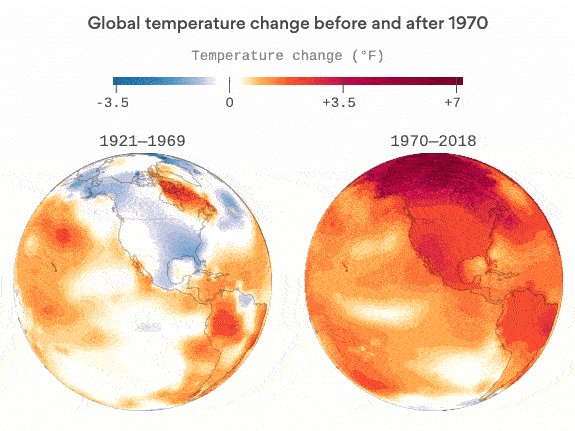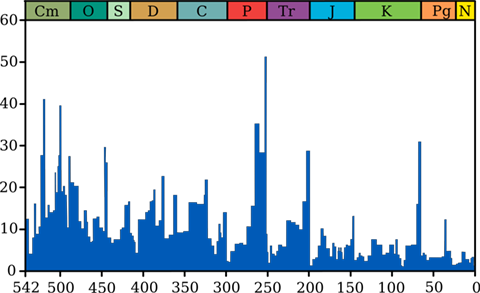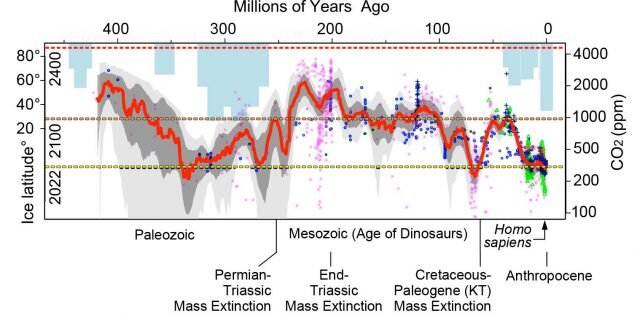
WEDNESDAY, JUNE 15, 2016

Bio 101
Pathway to Humans
Eric Lee, A-SOCIATED PRESS
TOPICS: FROM SCIENTISTS, FROM THE WIRES, FUTURE ISSUES
Abstract: Some say we are presiding over the sixth mass extinction event, but others count nine (six in the Phanerozoic). Either way we have become a pathogen on the face of the earth.
TUCSON (A-P) — In short:
- Abiotic organic resources left over from solar system formation serve as potential energy source.
- Via unknown pathway, chemical entities catabolize organic matter for energy and become self-replicating.
- Biotic entities evolve into diverse anaerobes able to use iron, sulfur and other elements and compounds as electron acceptors for energy.
- Photons are consumed by cyanobateria for energy, with oxygen as a waste product leading to Mass Extinction Event I (2.4 billion years ago) where anaerobes die off in oxygenated areas such as oceans.
- Aerobes evolve to use oxygen as energy source.
- Prokaryotes evolve into a community of mutualists living within a cell membrane to become eukaryotes having a nucleus.
- Eukaryotes evolve into multicellular organisms; some reproduce sexually.
- Snowball Earth caused about 70% of species to go extinct in the Cryogenian Mass Extinction Event II.
- Kingdom Animalia emerges, and some survive the Ediacaran Mass Extinction Event III (50% extinction), around 540–550 million years ago, possibly associated with meteorite impacts or ecosystem changes by early metazoans with oxygen drop (50% species extinction).
- Cambrian explosion in diversity, marine organisms capture carbon dioxide, levels drop as limestone deposits form causing global cooling and deoygenation resulting in late Cambrian Mass Extinction Event IV (End-Botomian mass extinction, 513 to 509 million years ago, an 80% species extinction); some chordates survive.
- Some vertebrates survive the Late Ordovician Mass Extinction Event V (85% species extinction) 445 Ma caused by global cooling and glaciation possibly associated with the uplifting Appalachian Mountains where weathering caused a significant and rapid drawdown of CO2 or perhaps by a solar gamma ray burst destroying the ozone layer.
- Some tetrapods survive the Late Devonian Mass Extinction Event VI (80% species extinction), possibly related to the expansion of terrestrial plants that used and sequester carbon dioxide decreasing the amount in the atmosphere, or meteorites, volcanism or both.
- Followed by the End Devonian Mass Extinction Event VII (50% extinction) 359 million years ago.
- Olson's Mass Extinction Event VIII, 60% extinction, 273 Ma, possibly caused by a hot climate and acidic waters.
- Capitanian Mass Extinction Event IX of 262-259 million years ago has been recently named. Volcanic emissions resulted in a severe disturbance of the carbon cycle.
 Some terrestrial tetrapods survive the Permian–Triassic Mass Extinction Event X (81% species extinction of marine species), likely caused by volcanic eruptions increasing carbon dioxide levels causing global warming or rapid warming may have been caused by release of methane from clathrates. Actually an organism, Methanosarcina, has been claimed to have done it. The 'great dying' resulted from rapid warming of around 10C (18F). Oceans lost around 80% of their oxygen, with parts of the seafloor becoming completely oxygen-free.
Some terrestrial tetrapods survive the Permian–Triassic Mass Extinction Event X (81% species extinction of marine species), likely caused by volcanic eruptions increasing carbon dioxide levels causing global warming or rapid warming may have been caused by release of methane from clathrates. Actually an organism, Methanosarcina, has been claimed to have done it. The 'great dying' resulted from rapid warming of around 10C (18F). Oceans lost around 80% of their oxygen, with parts of the seafloor becoming completely oxygen-free.
Recent research, published in Nature Geoscience (19 October 2020) provides, for the first time, a maybe conclusive picture of the underlying mechanism and consequences of the extinction and finally answers the key questions – what exactly caused Earth’s biggest mass extinction and how could an event of such a deadly magnitude unfold?
The team were able to determine that the trigger of the Permian-Triassic crisis was a large pulse of CO2 to the atmosphere originating from a massive flood basalt province, the result of a giant volcanic eruption in today’s Siberia. Analyses showed that the volcanisms released more than 100,000 billion tonnes of carbon into the atmosphere, triggering the onset of the extinction. This is more than 40 times the amount of all carbon available in modern fossil fuel reserves including carbon already burned since the industrial revolution.
So, our Anthropocene mass extinction event, caused by human sprawl and rapaciousness, is unlikely to rival that of the Permian. But the added stressor of climate change, so far a minor cause of extinctions, could add to humanity's footprint enough to eliminate its descendants, posterity, which will begin a new era.- Some early mammals survive the Triassic-Jurassic Mass Extinction Event XI (35% species extinction), likely caused by another bout of volcanic activity and global warming. Feathered dinosaurs survive and thrive in the Jurassic.
- Some early primates survive the late Cretaceous Mass Extinction Event XII 66 million years ago (78% species extinction), following meteor impact.
- Some humans may survive the Anthropocene Mass Extinction Event XIII caused by planetary life-support system degradation secondary to technology enabled consumptive growth by hunter-gatherers (e.g. megafauna extinctions), agropastoralists, and fossil-fueled modern global techno-industrial society. This event is also the First Mass Extermination Event of life on Earth by a carcinogenic invasive species.
- Current rate of extinction is about 1,000 times greater than before the Neolithic and the rate is increasing. The pace of planetary biosphere destruction has not slowed. Extinction rate may be 10,000 times greater by the end of the twenty-first century. Volcanism did not release the remnant fossil fuel reserves in Earth's crust to enhance the Anthropocene mass extinction event. It took technology-enabled humans pursuing short-term self interests to do so. And then what?

---------------------------------------------
The past has been warmer, and life persisted. If too hot for most life on land, sea life may recover post Anthropocene and flourish as it did in the Cambrian. During the Cambrian Period, which lasted from 542 million to 485.4 million years ago, CO2 levels may have been about 20 times higher than today (8k ppm, and 6k ppm about 200 million years ago), and temperatures were hotter by 10 degrees Celsius.
A future paleontologist may note, with a flick of her tentacle, that the Anthrocene, though it caused most land life to pass away, including the Anthro species (notable for building ruins) that caused it, that aquatic life would not have evolved to produce the Aqulians, the pinnacle of the evolution of life on Earth.

For details: Human Origins in Deep Time.
